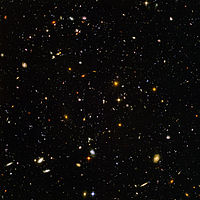- Mediocrity principle
-
"Mediocre" redirects here. For the album by Ximena Sariñana, see Mediocre (album).
The mediocrity principle is the notion in philosophy of science that there is nothing very unusual about the evolution of our solar system, the Earth, any one nation, or humans. It is a heuristic in the vein of the Copernican principle, and is sometimes used as a philosophical statement about the place of humanity. The idea is to assume mediocrity, rather than starting with the assumption that a phenomenon is special or has somehow violated the laws of the universe.[1][2]
Contents
The Copernican principle
 The Hubble Ultra Deep Field's finding that dark spots in the night sky contain thousands of other galaxies illustrates the mediocrity principle: what is special to us is just one of many.
The Hubble Ultra Deep Field's finding that dark spots in the night sky contain thousands of other galaxies illustrates the mediocrity principle: what is special to us is just one of many.
The mediocrity, as the Copernican principle, states that life on Earth depends on just a few basic molecules, the elements that make up these molecules are (to a greater or lesser extent) common to all stars, and the laws of science we know apply to the entire universe (and there is no reason to assume that they do not). Given sufficient time, it seems reasonable to expect that life would originate somewhere, and has probably originated elsewhere in the cosmos.[3] This idea is bolstered by Edwin Hubble's discovery that the universe is substantially larger than humans first thought. The Hubble Deep Field is a long exposure of thousands of galaxies, making it one of the best pictorial representations of the principle of mediocrity.
The traditional formulation of the Copernican mediocrity principle is usually played out in the following way: Ancients of the Middle East and west once thought that the Earth was at the center of the universe, but Copernicus proposed that the Sun was at the center. In the 1930s, RJ Trumpler found that the solar system was not at the center of the Milky Way Galaxy (as Jacobus Kapteyn claimed), but 56% of the way out to the rim from the galaxy's core. In the mid-twentieth century, George Gamow (et al.) demonstrated that although it appears that our Galaxy is at the center of an expanding universe (in accordance with Hubble's law), every point in space could be experiencing the same phenomenon. And, at the end of the twentieth century, Geoff Marcy and colleagues discovered that extrasolar planets are quite common, putting to rest the idea that the Sun is unusual in having planets. In short, Copernican mediocrity is a series of astronomical findings that the Earth is a relatively ordinary planet orbiting a relatively ordinary star in a relatively ordinary galaxy which is one of countless others in a giant universe, possibly within an infinite multiverse.[citation needed]
Other uses of the heuristic
The mediocrity principle as applied to humanity is supported by much of the evidence of common descent. Such evidence (from fossils, genetics, morphology, etc.) suggests that all humans have a common ancestor about 100,000 years ago, and that they share a common ancestor with chimpanzees and bonobos about six million years ago. By some measures, Humans share about 98% of their DNA with chimpanzees. When the Human Genome Project released its findings in 2003, it was discovered that the human genome only has 24,000 genes. As recently as the 1990s, humans were considered so complex as to have about 300,000 genes. Chimpanzees have actually undergone more genetic change than humans.[4] This data places human animals firmly as members of the biosphere rather than somehow above it.[citation needed]
Abiogenesis is likewise pursuing an answer to Schrödinger's question "What is Life?", and rather than supporting some form of vitalism, evidence is breaking down the barriers between life and nonlife. Francis Crick's "Astonishing Hypothesis" is that consciousness is simply the function of the brain. This possibility is also related to research into the Neuroscience of free will. PZ Myers believes the mediocrity principle can be taken further. He believes that careful use of the heuristic reminds individuals not to hold their own country, nor their own preferences, in too unique or special a regard.[2] Other sciences are humbling humankind similarly, whether it is Evolutionary psychology discovering the limits to human rationality, biological psychology exposing the material nature of cognition and moral sense with neuroimaging, or economic and political studies finding regularities in the behaviors of large groups of humans.
See also
- Anthropic principle - the only universe that we can observe is one that allows for our existence.
- Copernican principle
- Cosmic pluralism
- Cosmological principle - viewed on a sufficiently large scale, the properties of the Universe are the same for all observers
- Deep ecology
- Drake equation
- Geocentric cosmology of Aristotle and Ptolemy
- Neocatastrophism
- Plenitude principle
- Ptolemaic system
- The Rare Earth hypothesis is the antithesis of the Mediocrity principle
- Total Perspective Vortex
- Uniformity principle
- Cosmicism
Notes
- ^ Encyclopedia Britannica
- ^ a b PZ Myers explains the Mediocrity principle at edge.org
- ^ Chaisson, Eric, and Steve McMillan. Astronomy: A Beginner’s Guide to the Universe [1]. Ed. Nancy Whilton. San Francisco: Pearson, 2010.
- ^ Chimps More Evolved Than Humans | LiveScience
References
- Gonzalez, Richards, The Privileged Planet: How Our Place in the Cosmos is Designed for Discovery, Regnery Publishing, 2004, ISBN 0-89526-065-4
- Peter Ward and Donald Brownlee, Rare Earth: Why Complex Life is Uncommon in the Universe, Copernicus Books, January 2000, ISBN 0-387-98701-0
External links
- Goodwin, Gribbin, and Hendry's 1997 Hubble Parameter measurement relying on the mediocrity principle The authors call this the 'Principle of Terrestrial Mediocrity' even though the assumption they make is that the Milky Way Galaxy is typical (rather than Earth). This term was coined by Alexander Vilenkin (1995).
Categories:- Earth
- Philosophy of science
- Principles
- SETI
Wikimedia Foundation. 2010.
